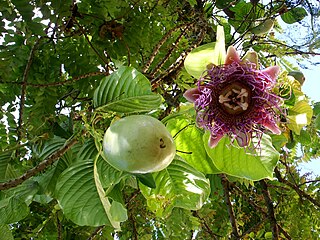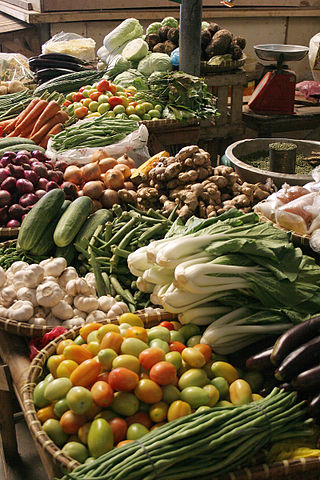
Tropical horticulture is a branch of horticulture that studies and cultivates plants in the tropics, i.e., the equatorial regions of the world. The field is sometimes known by the portmanteau "TropHort".

Tropical horticulture is a branch of horticulture that studies and cultivates plants in the tropics, i.e., the equatorial regions of the world. The field is sometimes known by the portmanteau "TropHort".
Tropical horticulture includes plants such as perennial woody plants (arboriculture), ornamentals (floriculture), vegetables (olericulture), and fruits (pomology) including grapes (viticulture). The origin of many of these crops is not in the tropics but in temperate zones. Their adoption to tropical climatic conditions is an objective of breeding. Many important crops, however, are indigenous to the tropics. The latter embrace perennial crops such as oil palm, vegetables including okra, field crops such as rice and sugarcane, and particularly fruits including pineapple, banana, papaya, and mango.[ citation needed ]
Since the tropics represent 36 percent of the Earth's surface and 20 percent of its land surface, the potential of tropical horticulture is huge. [1] In contrast to temperate regions, environmental conditions in the tropics are defined less by seasonal temperature fluctuations and more by seasonality of precipitation. Thus the climate in the greater part of the tropics is characterized by distinct wet and dry seasons, although such variation is reduced in locations closer to the equator (±5° latitude). Temperature conditions in the tropics are affected by elevation, [2] in which contrasting warmer and colder climate areas in the tropics can be differentiated, [3] : 4–5 and highland areas in the tropics can consequently be more favourable for production of temperate plant species than are lowland areas.[ citation needed ]
Both vascular and non-vascular plants grow in tropical environments. Plants indigenous to the tropics are usually cold sensitive and adapted to receiving high levels of solar radiation. They are sensitive to small variations in photoperiod ("short day" plants), and can be adapted to extended drought, high precipitation and/or distinct wet and dry seasons. High night temperatures are a major hindrance to adopting temperate crops (e.g., tomatoes) to the tropical lowlands. Furthermore, such conditions promote high respiration rates of plants, resulting in comparably lower net photosynthesis rates. [4]

In geography, the temperate climates of Earth occur in the middle latitudes, which span between the tropics and the polar regions of Earth. These zones generally have wider temperature ranges throughout the year and more distinct seasonal changes compared to tropical climates, where such variations are often small and usually only have precipitation differences.

The tropics are the regions of Earth surrounding the Equator. They are defined in latitude by the Tropic of Cancer in the Northern Hemisphere at 23°26′10.1″ (or 23.43615°) N and the Tropic of Capricorn in the Southern Hemisphere at 23°26′10.1″ (or 23.43615°) S. The tropics are also referred to as the tropical zone and the torrid zone.

In the fields of horticulture and botany, the term deciduous means "falling off at maturity" and "tending to fall off", in reference to trees and shrubs that seasonally shed leaves, usually in the autumn; to the shedding of petals, after flowering; and to the shedding of ripe fruit. The antonym of deciduous in the botanical sense is evergreen.

Horticulture is the art and science of growing plants. This definition is seen in the etymology of "horticulture", which is derived from the latin words hortus, which means "garden" and cultura which means "to cultivate". Horticulture is very broad and encompasses many areas, which means that there are many different types of horticulturists. In anthropology, horticulture refers to a subsistence strategy characterized by the small-scale, non-industrial cultivation of plants for food. Horticulture is normally small-scale or ornamental, as compared to the larger-scale cultivation of crops that is seen in agriculture.

The subtropical zones or subtropics are geographical and climate zones to the north and south of the tropics. Geographically part of the temperate zones of both hemispheres, they cover the middle latitudes from 23°26′10.1″ (or 23.43615°) to approximately 35° north and south. The horse latitudes lie within this range.

A polytunnel is a tunnel typically made from steel and covered in polyethylene, usually semi-circular, square or elongated in shape. The interior heats up because incoming solar radiation from the sun warms plants, soil, and other things inside the building faster than heat can escape the structure. Air warmed by the heat from hot interior surfaces is retained in the building by the roof and wall. Temperature, humidity and ventilation can be controlled by equipment fixed in the polytunnel or by manual opening and closing of vents. Polytunnels are mainly used in temperate regions in similar ways to glass greenhouses and row covers. Besides the passive solar heating that every polytunnel provides, every variation of auxiliary heating is represented in current practice. The nesting of row covers and low tunnels inside high tunnels is also common.

Floriculture is the study of the efficient production of the plants that produce showy, colorful flowers and foliage for human enjoyment and the human environment. It is a commercially successful branch of horticulture and agriculture found throughout the world. Efficient production practices have been developed over the years, for the hundreds of plant taxa used in the floral industry, increasing the overall knowledge of whole plant biology. Plant breeding and selection have produced tens of thousands of new genotypes for human use. Jasmine, Marigold,Chrysanthemum, Rose, Orchid, Anthurium etc. are flowers of commercial demand.

Tropical rainforests are dense and warm rainforests that occur in tropical rainforest climate where there is no dry season – all months have an average precipitation of at least 60 mm. True rainforests are typically found between 10 degrees north and south of the equator ; they are a subset of the tropical forest biome that occurs roughly within the 28-degree latitudes. Tropical rainforests are a type of tropical moist broadleaf forest, that includes the more extensive seasonal tropical forests.

The wet season is the time of year when most of a region's average annual rainfall occurs. Generally, the season lasts at least one month. The term green season is also sometimes used as a euphemism by tourist authorities. Areas with wet seasons are dispersed across portions of the tropics and subtropics.

Pomology is a branch of botany that studies fruits and their cultivation. Someone who researches and practices the science of pomology is called a pomologist. The term fruticulture is also used to describe the agricultural practice of growing fruits in orchards.

Passiflora quadrangularis, the giant granadilla, barbadine (Trinidad), grenadine (Haiti), giant tumbo or badea, is a species of plant in the family Passifloraceae. It produces the largest fruit of any species within the genus Passiflora. It is a perennial climber native to the Neotropics.

Bactris gasipaes is a species of palm native to the tropical forests of Central and South America. It is well spread in these regions, where it is often cultivated by smallholders in agroforestry systems or more rarely, in monoculture. Common names include peach palm in English, among others used in South American countries. It is a long-lived perennial plant that is productive for 50 to 75 years on average. Its population has an important genetic diversity, leading to numerous fruits, colors, and qualities. The fruits are edible and nutritious but need to be cooked for 30 minutes to five hours. They also benefit many animals in the wild. Peach-palms are also cultivated for the heart of palm, and the trunk can make valuable timber.

Worldwide more human beings gain their livelihood from agriculture than any other endeavor; the majority are self-employed subsistence farmers living in the tropics. While growing food for local consumption is the core of tropical agriculture, cash crops are also included in the definition.

When the Spanish arrived, they divided Peru into three main regions: the coastal region, that is bounded by the Pacific Ocean; the highlands, that is located on the Andean Heights, and the jungle, that is located on the Amazonian Jungle. But Javier Pulgar Vidal, a geographer who studied the biogeographic reality of the Peruvian territory for a long time, proposed the creation of eight Natural Regions. In 1941, he presented his thesis "Las Ocho Regiones Naturales del Perú" at the III General Assembly of the Pan-American Institute of Geography and History.

Vegetables are parts of plants that are consumed by humans or other animals as food. The original meaning is still commonly used and is applied to plants collectively to refer to all edible plant matter, including the flowers, fruits, stems, leaves, roots, and seeds. An alternative definition of the term is applied somewhat arbitrarily, often by culinary and cultural tradition. It may exclude foods derived from some plants that are fruits, flowers, nuts, and cereal grains, but include savoury fruits such as tomatoes and courgettes, flowers such as broccoli, and seeds such as pulses.

Olericulture is the science of vegetable growing, dealing with the culture of non-woody (herbaceous) plants for food.

Jute mallow or Nalita jute is a species of shrub in the family Malvaceae. Together with C. capsularis it is the primary source of jute fiber. The leaves and young fruits are used as a vegetable, the dried leaves are used for tea and as a soup thickener, and the seeds are edible.
Tropical Asia refers to the entirety of the areas in Asia with a tropical climate. These areas are of geographic and economic importance due to their natural resources and biodiversity, which include many species of agricultural value. There are 16 countries in tropical Asia, ranging in size from around 610 square kilometres (Singapore) to 3,000,000 km2 (1,200,000 sq mi) (India). The total population as of 2006 was 1.6 billion, predominantly rural, and projected to reach 2.4 billion by 2025. Climate in tropical Asia is subject to seasonal weather patterns with the two monsoons and the amount of tropical cyclones in the three core areas of cyclogenesis. Stressors on the environment include growing urbanization, land industrialization, economic development, land degradation, environmental issues, and increased pollution, all of which are contributing to changes in climate.

The primary form of agriculture in Sri Lanka is rice production. Rice is cultivated during Maha and Yala seasons. Tea is cultivated in the central highlands and is a major source of foreign exchange. Vegetables, fruits and oilseed crops are also cultivated in the country. There are two Agriculture Parks abbreviated as A. Parks established by the Department of Agriculture. Out of the total population in Sri Lanka, 27.1% engages in agricultural activities. Agriculture accounted for 7.4% of the GDP in 2020.

College of Horticulture Mudigere is a horticulture college located in Mudigere, Karnataka, India. Established in 1991, it is affiliated to the University of Agricultural and Horticultural Sciences, Shivamogga and was previously affiliated to the University of Horticultural Sciences, Bagalkot. This horticultural education center is the oldest in Karnataka. The college has been accredited by the Indian Council of Agricultural Research since 25 August 2004.